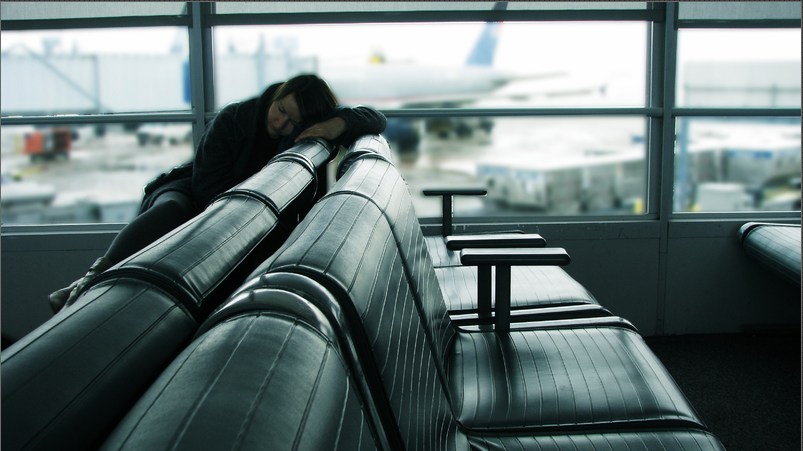My previous post focused on the role of light and darkness in jet lag – as has most research into the effects of environmental time cues in both animals and humans. But there is mounting evidence that other factors also play an important role. Chief among these are activity and rest – which can therefore also be used to help you overcome jet lag’s effects. Studies suggest that activity might play a role similar to that of light in shifting circadian rhythms (essentially, your body clock). In attempting to minimise your jet lag, it is therefore generally desirable to be active at those times when you should be exposed to light. It is quite likely that combining light and activity may actually have a more powerful effect than each of those factors alone. So when you get to your destination during daylight hours, that another reason why getting out and doing things is preferable to immediately sacking out in your hotel room.
Just as activity appears to have an effect on circadian rhythms similar to that of light, so rest may work in a manner similar to dark. You may do better to remain at rest at those times of day when you need to be exposed to darkness. In situations where you’re unable to be in the dark at the required time, simply resting by itself may be helpful.
Unusual Sleep-Wake Patterns: “Night Owls” and “Early Birds”
The directions as to when you should be exposed to light and to darkness are geared toward those individuals with typical sleep-wake patterns – that is, those who usually go to sleep between 10 PM and midnight and wake up between 6 and 8 AM. Those whose patterns of sleeping and waking fall outside this range should adjust the directions accordingly.
For example, if you usually go to sleep after midnight, add extra time onto all the instructions, hour for hour. Say your usual sleep onset time is 1 AM, your usual wake up time is 9 AM, and the instructions tell you to avoid light and minimize activity at 5 PM. in the time zone of your destination, instead put on your dark glasses at 6 PM in your destination time zone. For those of you who normally go to sleep and wake up early, subtract from the times given in the directions the difference between your times of sleeping and waking and those “typical times” mentioned above.
So what formula could you use?
(For the following, use the following time convention: ITZ = Initial Time Zone, TZT = Time Zones Travelled.)
Travelling East
Overnight 1
Between 10 PM and 4 AM ITZ, avoid light and minimise activity.
From 4 AM until 7 AM ITZ, maximise light exposure and activity.
Your switch-point is now likely around 2 AM ITZ.
Overnight 2
On your first night at your destination, avoid light and minimise activity between 7 PM and 2 AM ITZ.
The next morning at your destination, maximise light exposure and activity between 2 and 5 AM ITZ.
Your switch point is now likely around midnight ITZ.
If TZT is 6 or greater, you will want to go through at least one more adjustment cycle, as described here:
Overnight 3
On this second night at your destination, avoid light and minimise activity between 7 PM and midnight ITZ.
On the next morning, maximise light exposure and activity between midnight and 3 AM ITZ.
Your switch point is now likely around 10 PM ITZ.
Travelling West:
Overnight 1
If you are leaving before 10 AM ITZ, avoid light and minimise activity as much as possible before 10 AM ITZ.
From 11 PM until 3 AM ITZ, maximise light exposure and activity.
Between 4 AM ITZ and 10 AM ITZ on the first overnight of travel, avoid light and minimise activity.
Your switch point is now likely around 6 AM ITZ.
Overnight 2
Maximise light exposure and activity between midnight and 3 AM ITZ.
Avoid light and minimise activity between 6 AM and noon ITZ.
Your switch point is now likely around 8 AM ITZ.
If TZT is 6 or greater, you will want to go through at least one more adjustment cycle, as described here:
Overnight 3
Maximise light exposure and activity between 1 and 4 AM ITZ.
Avoid light and minimise activity between 8 AM and 2 PM ITZ.
Your switch point is now likely around 10 AM ITZ.
Dan A. Oren, MD, Visiting Professor of Biotechnology at the University of Rzeszów and member of the psychiatry department at Yale University. He is a co-author of How to Beat Jet Lag: A Practical Guide for Air Travelers, with Walter Reich, MD, Norman E. Rosenthal, MD, and Thomas A. Wehr, MD. Dr. Oren is a volunteer member of the board of the Center for Environmental Therapeutics (cet.org), whose website provides more information about biological rhythms and products that are designed to improve matching our biological rhythms with the world around us.
image | Pratibha Varshney


